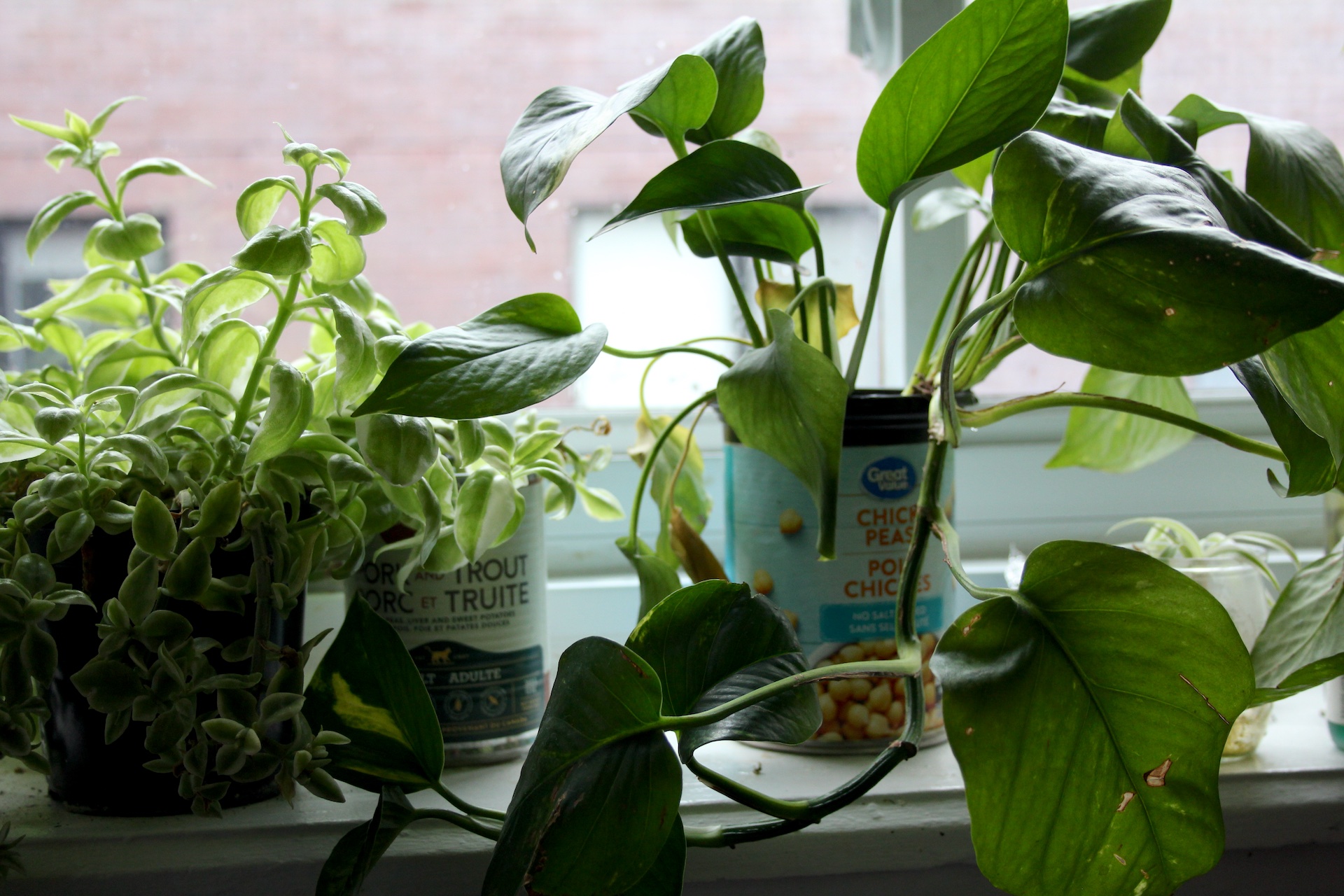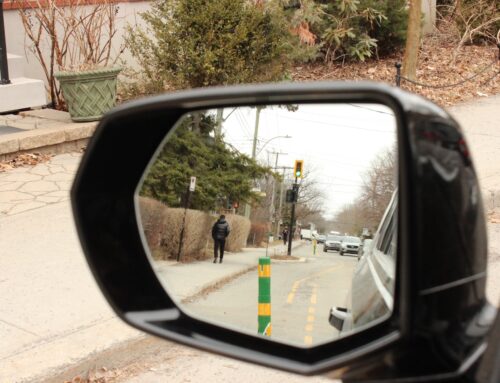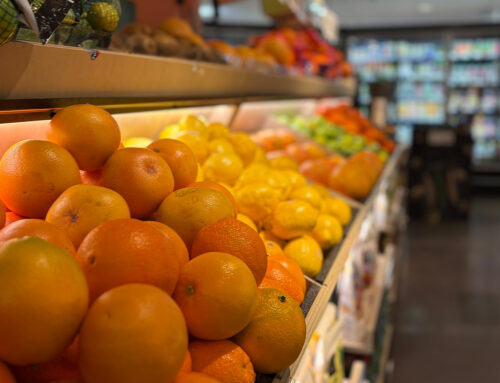BY Bree Rockbrand & Lynn Fattal
Sara McQuaid’s kitchen cupboard is filled with repurposed mason jars.
In another life, a jar that once contained pasta sauce is now filled with M&Ms. Another holds sour gummy worms, and another, boiling with irony, dry pasta. Her fridge is stocked with fresh fruits and vegetables, most of which she buys without plastic packaging. She separates her waste into different bins, making sure to recycle and compost, even though it takes up space in her kitchen. Her sweater, like most of her wardrobe, is second-hand.
“I’m kind of coming back to that sense of like, somebody made this, and now I’m responsible for it, and I need to treat it well because when I’m done with this, where is it going to go?” asks McQuaid. “To the ocean? To a landfill? God knows where. That shift is really, really, really scary and overwhelming, but it’s needed so badly right now.”
McQuaid’s been living a zero-waste lifestyle since 2022, when she moved to Montreal. Her interest in the lifestyle was sparked after an experience she had while living in Asia.
“I walked into this grocery store and all the bananas in the store were single wrapped in Styrofoam containers wrapped in plastic, and I thought to myself, that’s the stupidest thing I’ve ever seen,” she says. “It got me thinking, wow, all of that Styrofoam right there. If they threw all of that out right now, that would be like a whole dumpster’s worth of Styrofoam.”
She thought about the piles of food that are wasted every day. From then, McQuaid says, she began to consider her own patterns.
She doesn’t drive a car, shops at second-hand stores, and tries her best to buy groceries from zero waste and bulk stores. McQuaid knows she is an outlier – while zero-waste living is growing in popularity, it is still far from the norm.

McQuaid tidies up her closet, made up almost exclusively of second hand clothing. Photo by Bree Rockbrand.
The City of Montreal is on its own journey to become a zero-waste city. 2025 marks the end of Montreal’s Zero-Waste 2020-2025 plan. The fourth iteration of a larger effort to meet their 2030 zero-waste goal, this plan includes significantly reducing waste generation by promoting recycling and composting, and minimizing the environmental impact of waste disposal.
While Montreal manages 930,000 tons of waste per year produced by two million residents, the 2020-2025 plan of action includes five different door-to-door collections and seven eco centers where people can drop off a variety of items.
Marie-Andrée Mauger, mayor of Verdun and one of the leaders of Montreal’s ecological transition, believes the plan has been successful so far.
“More than half the boroughs of Montreal have already reached the target of producing less than 400 kilos of waste per person per year,” she says.
According to Mauger, this includes all types of waste, from organics to recyclable materials.
Montreal is still underway to deploy collection at every door in the city, says Mauger, including around 40,000 businesses, industries or institutions that have municipal waste collection. Other initiatives to reduce waste include programs designed to educate citizens on proper waste management separation.
What the plan doesn’t include are the businesses and institutions that have their own waste collection services, like chain grocery stores. Mauger acknowledges this gap, expressing the importance of moving towards a circular economy.
“It’s not only about recycling once, but to create a circle where we reuse the same material many times,” she explains.
Simon Langlois-Betrand, a researcher on circular economy paradigms and life-cycle thinking, explains that a circular economy aims to reduce the energy use of raw material extraction and production, recycling, and reimagining product design to fit a more sustainable model.
“You need energy to extract the minerals. You need energy to manufacture it. You need energy to use it,” he explains. “ And even if you recycle [the product], you can say, oh, I’ve saved on extraction. But if it requires you a ton of electricity just to do that, then maybe you’re not necessarily better off in the end.
“So there are different dimensions,” he continues. “One is recycling more, two is reducing the energy use, and the third one is to reimagine a little bit the whole cycle of the product. It’s not just about recycling at the end. It’s also about adding services, like repair shops and elaborating designs for products so that they’re easier to recycle to begin with.”

McQuid shows off the celery she received through “Odd Bunch”, a subscription service that delivers “imperfect” produce that would otherwise be thrown out. Photo by Bree Rockbrand.
Recycling, which emerged largely in the 1990s in Canada, was well-adapted to, explains Langlois-Bertrand, shifting waste from zero to 50-60 per cent. For the past 20 years, though, he says advancements in recycling have been stagnant.
He adds that Canadian recycling facilities are not equipped to treat all types of recyclable material, limiting the full potential of recycling services.
Organic waste is another matter. As of September 2024, 87 per cent of households in Montreal have access to organic waste collection, and Mauger relays the city plans to provide every household with a brown bin by the end of 2025. While composting is mandatory for all streets that have brown bin collection, over half of the contents of regular garbage contains organic materials that should be placed in a brown bin.
In October of 2024, Montreal opened its first composting plant in Saint-Laurent. Before this, all composting materials were going by truck up to 180 kilometers away, a process which would “spew out greenhouse gas emissions in the process,” according to Mayor Valérie Plante.
Noise complaints have forced several venues to shut down over the past decade. Infographic by Bree Rockbrand.
Langlois-Bertrand says that while collection services have improved in the last few years, there is still no not clear plan on what should be done with organic waste.
“We need to ensure that the collected organic waste is used in a sustainable way, either through composting or turning it into topsoil,” he says.

McQuaid’s Countertop compost, where she discards her coffee grinds each morning. Her main compost is in her fridge. Photo by Bree Rockbrand.
While more legislation surrounding sustainability could help zero-waste efforts, Langlois-Bertrand emphasizes the importance of balancing individual action and policy.
“At some point, we have to have buy-in from the population,” he says. “You can force it a little bit, but if you force it, you may get more resistance. If the regulations are disliked by many people, they’re gonna elect someone else. So, you need to have a balance.”
What is needed for businesses to get on the zero-waste train? Video by Lynn Fattal.
Mélissa de la Fontaine, advisor of zero waste lifestyles and author of the book Tendre vers le zéro déchet (Towards Zero Waste), says that a zero waste lifestyle isn’t always attainable.
“If we want people to make responsible choices and implicate themselves, then we have to give them room to maneuver, and right now people have no room to maneuver,” she says.
La Fontaine explains that shopping at zero-waste and bulk stores can be both time consuming and costly.
“When people are not doing well, you can’t ask them to do extra things at this level,” she says. “I think this is the key of the problem – people are stressed, people are strapped for cash for the most part, they work five days a week, they have kids, are not able to fill their weeks, and if we are asking them to grab their bags and go to zero-waste stores and fill them, it’s too much.”
With so many available products wearing badges like bio and organic, la Fontaine argues that it’s hard to know which product is the most sustainable.
“People have to make a choice. Is it more important to you that it’s in bulk, but it’s not local?” she asks. “It would take an analysis of the lifecycle of products, and we don’t have this information. That’s what makes people give up, because it’s too complicated.”
For those curious about starting their own zero waste journey, McQuaid suggests starting one step at a time.

McQuaid nurtures one of her pothos plants, which grows out of a repurposed can of chickpeas. Her cupboard is filled with repurposed mason jars containing bulk items to reduce plastic packaging. Photo by Bree Rockbrand.
“Make one change, do it really well, and then do the next change,” she says. “I think what happens is that there’s so much you can do that people jump in and they get really overwhelmed.”
As for McQuaid herself, it’s all about staying positive and doing what she can.
“I believe I’m doing my best. I believe my partner is doing their best. I don’t think my dog and cat are doing anything, but they’re there for moral support,” she laughs.




